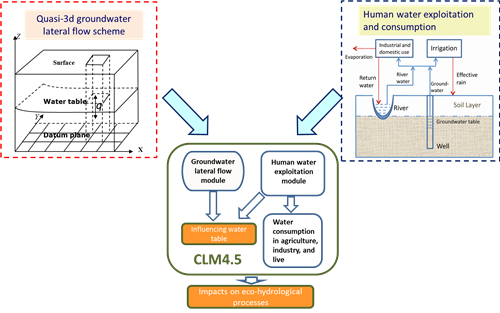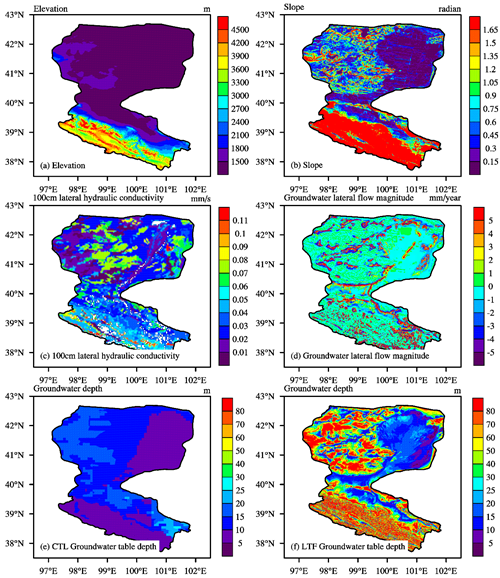Investigation of Heihe River Reveals Effects of Anthropogenic Water Regulation and Groundwater Lateral Flow
Date:2016-07-04
Anthropogenic water resources exploitation changes soil moisture and land-atmosphere water and energy fluxes, and essentially affects the ecological and hydrological processes. The over-exploitation has rapidly depleted available water resource in surface and subsurface, forming groundwater depletion cones in over-exploited regions, inducing natural disasters like drought, and causing unsustainability of water use. Groundwater lateral flow induced by the groundwater pumping can recharge the depleted aquifer. Understanding the effects of anthropogenic water regulation and groundwater lateral flow scientifically benefits human water resources management.
Recently, XIE Zhenghui and ZENG Yujin in LASG/Institute of Atmospheric Physics incorporated the schemes of anthropogenic water regulation and groundwater lateral flow into land surface model, and conducted a series of simulations over Heihe River Basin, northwest China to investigate the impacts of anthropogenic water regulation and groundwater lateral flow on ecological and hydrological processes. The framework of the coupled model and the map of Heihe River Basin are respectively shown in Fig. 1 and Fig. 2.

Fig. 1 Framework of the coupled model (Zeng et al., 2016)

Fig. 2 Heihe River Basin, the second largest inland river basin in northwestern China (Zeng et al., 2016)
Their results show that, anthropogenic water regulation and groundwater lateral flow have dramatically changed the water table pattern and related ecological and hydrological processes, as Fig. 3 shows. Over the last decade, groundwater table was deepened by ~2 m, and groundwater cones were formed in the over-exploitation regions of middle reaches, as shown by Fig. 4. The stream flow was also significantly reduced by human river water diversion. The groundwater lateral flow could recharge the groundwater depletion cones, and the effects were more significant in plains than in mountainous regions. Additionally, under stream water conveyance, the groundwater lateral flow plays an essential role in the controlling of existence and development of riparian ecological systems.

Fig. 3 Spatial distributions of (a) elevation (b) terrain slope (c) lateral hydraulic conductivity at 100 cm soil depth, (d) groundwater lateral flow magnitude as well as climatologic groundwater table depth distribution of the Heihe River Basin predicted by simulations from CLM4.5 (e) without groundwater lateral flow (CTL) and (f) with groundwater lateral flow scheme (LTF) (Zeng et al., 2016)

Fig. 4 Differences of spatial patterns between simulation results with and without human water regulation, for climatologic (a) groundwater table depth. (b) 100-cm soil moisture, (c) 2-cm soil moisture, (d) runoff, (e) river storage, (f) terrestrial water storage, (g) ground temperature, (h) latent heat flux and (i) sensible heat flux, over the time period of 2003-2013. (Zeng et al., 2016)
This research finding has been published in Journal of Advances in Modeling Earth Systems and Hydrology and Earth System Sciences.
Citation:
Yujin Zeng, Zhenghui Xie, Yan Yu, Shuang Liu, Linying Wang, Jing Zou, Peihua Qin, Binghao Jia. Effects of anthropogenic water regulation and groundwater lateral flow on land processes, 2016. Journal of Advances in Modeling Earth Systems. In press. doi:10.1002/2016MS000646.
(http://onlinelibrary.wiley.com/doi/10.1002/2016MS000646/full)
Yujin Zeng, Zhenghui Xie, Yan Yu, Shuang Liu, Linying Wang, Binghao Jia, Peihua Qin, Yaning Chen. Ecohydrological effects of stream–aquifer water interaction: a case study of the Heihe River basin, northwestern China, 2016. Hydrology and Earth System Sciences, 20, 2333-2352, doi:10.5194/hess-20-2333-2016.
(http://www.hydrol-earth-syst-sci.net/20/2333/2016/ )
